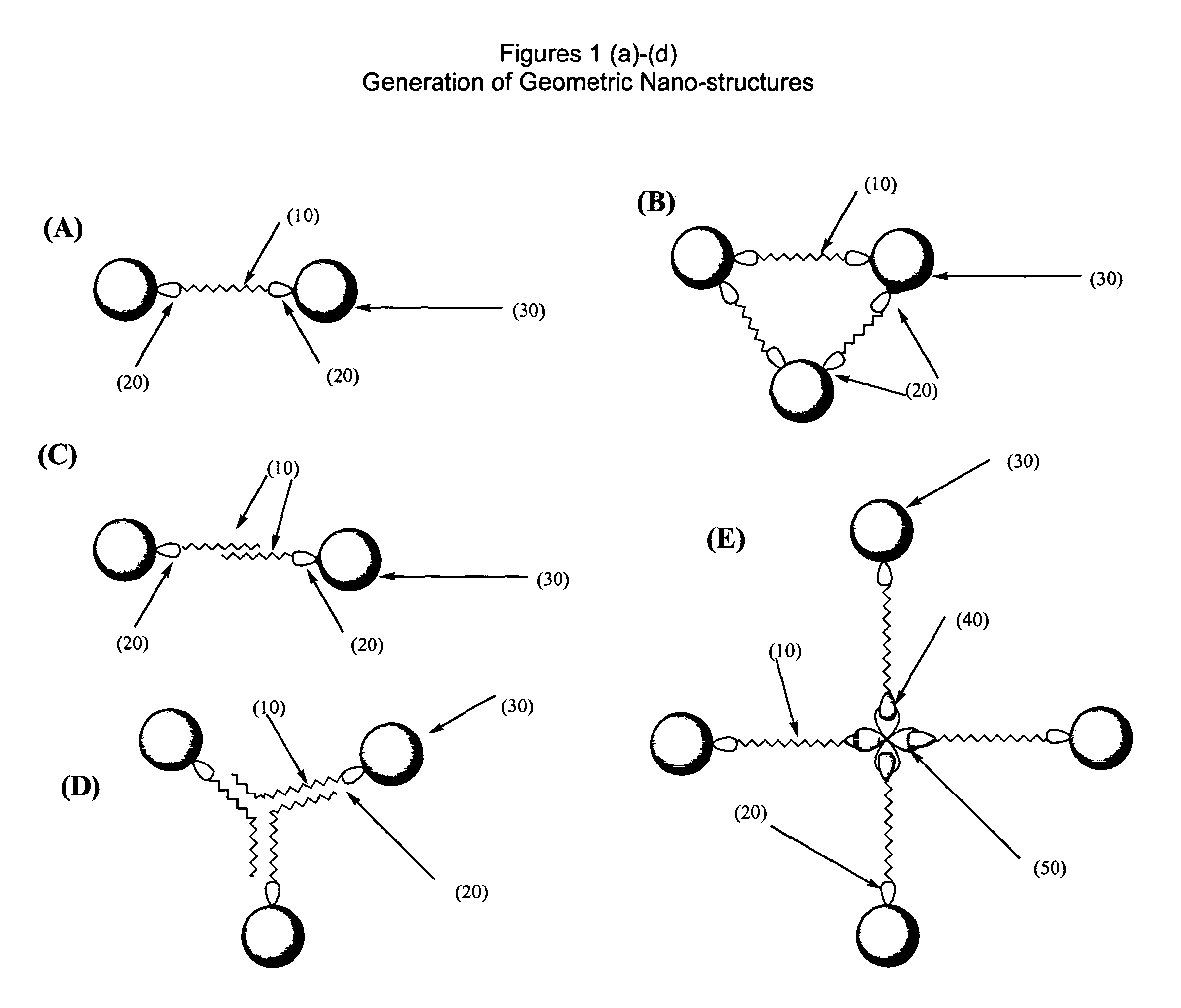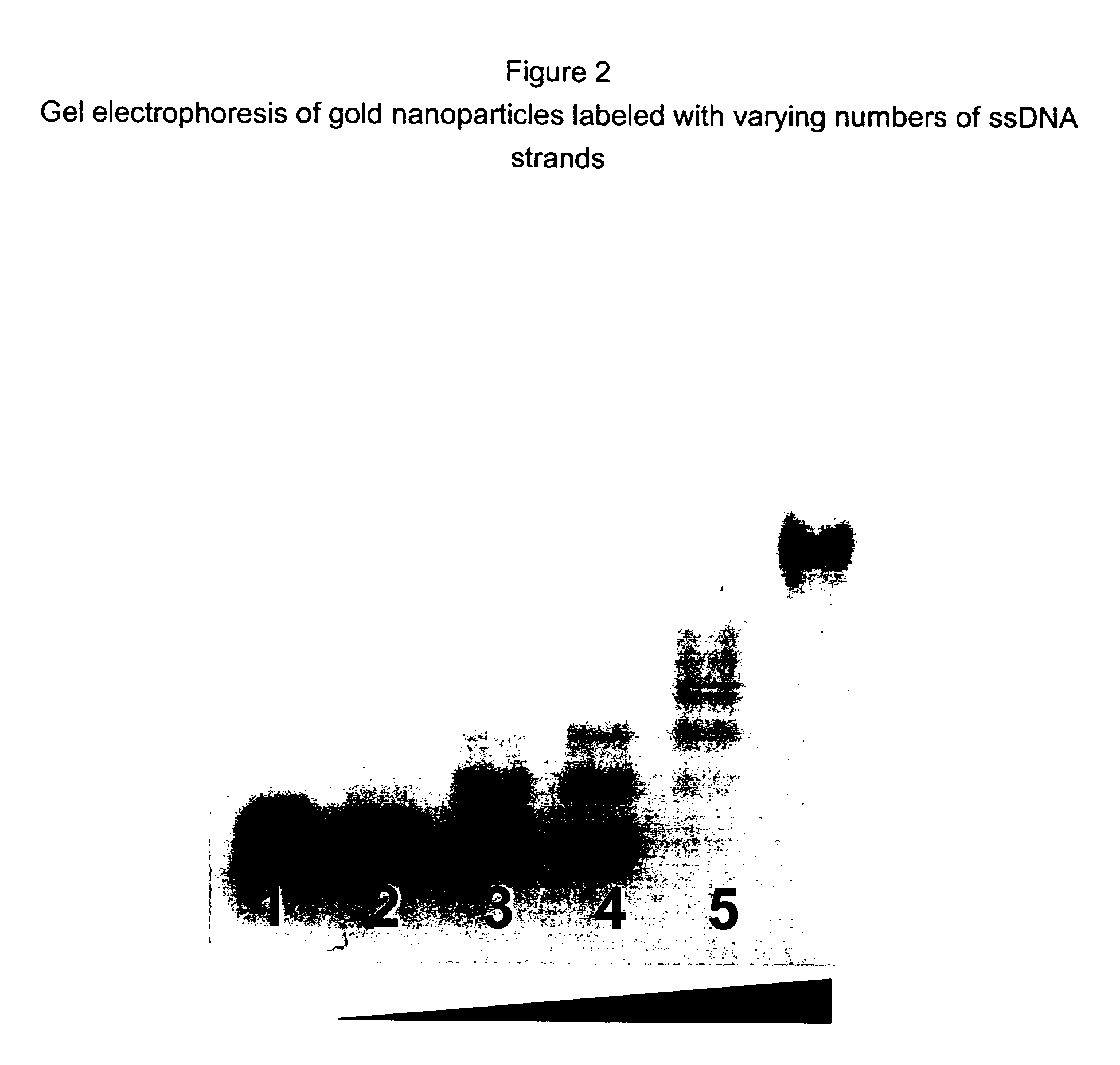Nanoparticle complexes having a defined number of ligands
a technology of ligands and complexes, which is applied in the field of metal nanoparticle preparation, can solve the problems of inability to reproducibly isolate nanoparticles comprising a single species of ligands in a rapid and facile manner, and difficulty in obtaining particles with a defined number of ligands via direct chemical transformation, and achieve the effect of size cutting o
- Summary
- Abstract
- Description
- Claims
- Application Information
AI Technical Summary
Problems solved by technology
Method used
Image
Examples
example 1
Particle Size Fractionation of Tiopronin Monolayer-Protected Gold Nanoparticles
[0110]The purpose of this Example was to prepare uniform size tiopronin monolayer-protected gold nanoparticles. The method comprises the fractional precipitation of the stabilized, charged, water-soluble nanoparticles by addition of a substantially water-miscible organic solvent in the presence of an electrolyte.
Preparation of Tiopronin Monolayer-Protected Gold Nanoparticles
[0111]Unless otherwise noted, all reagents were purchased from Aldrich (Milwaukee, Wis.) and were used without further purification. In a typical reaction, 60 mL of methanol (HPLC grade) and 10 mL of acetic acid (HPLC grade) were mixed in an Erlenmeyer flask by stirring for 2-5 min. Tetrachloroauric acid (HAuCl4. xH2O, 99.99%) (0.37 g) and 16.32 mg of N-(2-mercaptopropionyl)glycine (tiopronin) (99% minimum, obtained from Sigma, St. Louis, Mo.) were added to the above mixed solvents and dissolved by stirring for 5 min, resulting in a cl...
example 2
Labeling Gold Nanoparticles with Single-Stranded DNA
[0113]In this and other examples, single-stranded DNA (ssDNA) oligo nucleotides were purchased from Integrated DNA Technologies, INC (Coralville, Iowa), with 5′ C6 SH modification. The materials were used as received without further treatment. For this example, a ssDNA with sequence:
[0114]
986-ZF:[SEQ ID NO:1]AAA AAA GCG TGG GCG TGG GCG TGG GCG TGG GCG
was used. Gold particles used in this and all other examples were Au-Tp particles prepared in EXAMPLE 1, with a concentration of 60 μM in H2O. A titration experiment was set up by mixing appropriate amount of Au-Tp, ssDNA, NaCl, and H2O, as shown in the following table, in order to determine optimal ratio of Au-Tp vs. ssDNA for labeling reaction.
[0115]
Rxn 1Rxn 2Rxn 3Rxn 4Rxn 5Rxn 6Au-Tp333333(60 μM)SsDNA012481.6(40 μM)(400 μM)NaCl (1M)1.51.51.51.51.51.5H2O10.59.58.56.52.58.9Total (μL)151515151515Volume unit = μL
[0116]Each reaction was carried out in a 1.5 mL volume test tube. The react...
example 3
Separation of Gold Nanoparticles with Different Number of Single-Stranded DNAs
[0118]This example demonstrates that one can use size exclusion chromatography to obtain Au particles with exact number of ssDNAs attached. In this experiment, labeling reaction was done as follows. To 100 ul of Au-Tp (60 μM) was added 8 μL of 400 μM ssDNA (986-ZF) and 12 μL of 1 M NaCl. The reaction mixture was incubated at 60° C. for 15 min and allowed to slowly cool down to room temperature in 30 min.
[0119]The above-mentioned reaction mixture was then injected into a Superdex 200 gel filtration column (Amersham Biosciences, Piscataway, N.J.) mounted on a BioCAD / SPRINT HPLC system (PerSeptive Biosystems, Framingham, Mass.), and eluted with 0.05 NaCl / 0.15 M NaHPO4 buffer (pH 7) at a flow rate of 0.5 mL / min. The elution profile is shown in FIG. 3A. Peak 1,2 and 3 corresponds to nanoparticles labeled with 2, 1 and 0 ssDNA. In FIG. 3B, a gel image is shown comparing Au-Tp (lane1), Au-Tp / ssDNA reaction mix (l...
PUM
| Property | Measurement | Unit |
|---|---|---|
| diameter | aaaaa | aaaaa |
| pore size | aaaaa | aaaaa |
| size | aaaaa | aaaaa |
Abstract
Description
Claims
Application Information
 Login to View More
Login to View More - R&D
- Intellectual Property
- Life Sciences
- Materials
- Tech Scout
- Unparalleled Data Quality
- Higher Quality Content
- 60% Fewer Hallucinations
Browse by: Latest US Patents, China's latest patents, Technical Efficacy Thesaurus, Application Domain, Technology Topic, Popular Technical Reports.
© 2025 PatSnap. All rights reserved.Legal|Privacy policy|Modern Slavery Act Transparency Statement|Sitemap|About US| Contact US: help@patsnap.com



